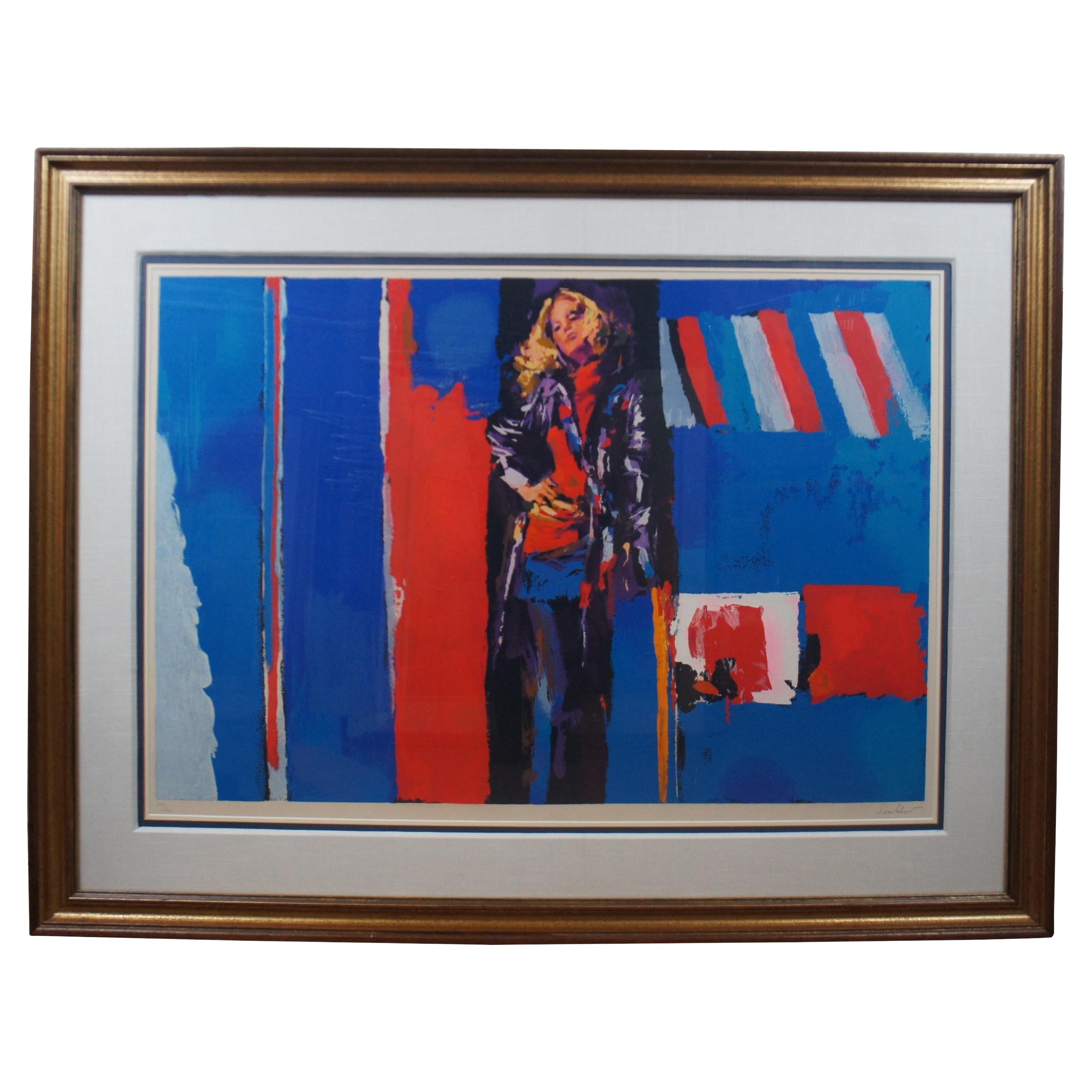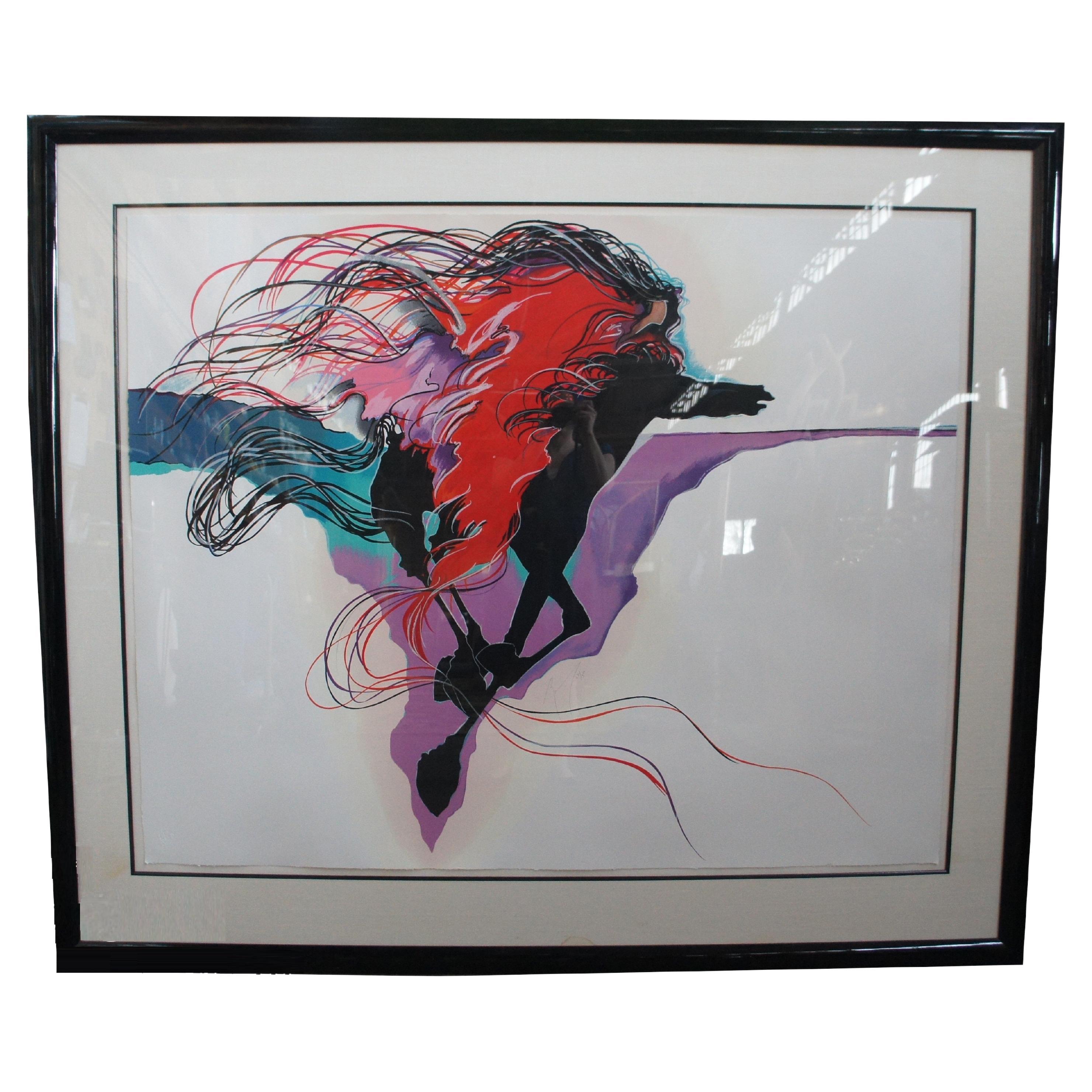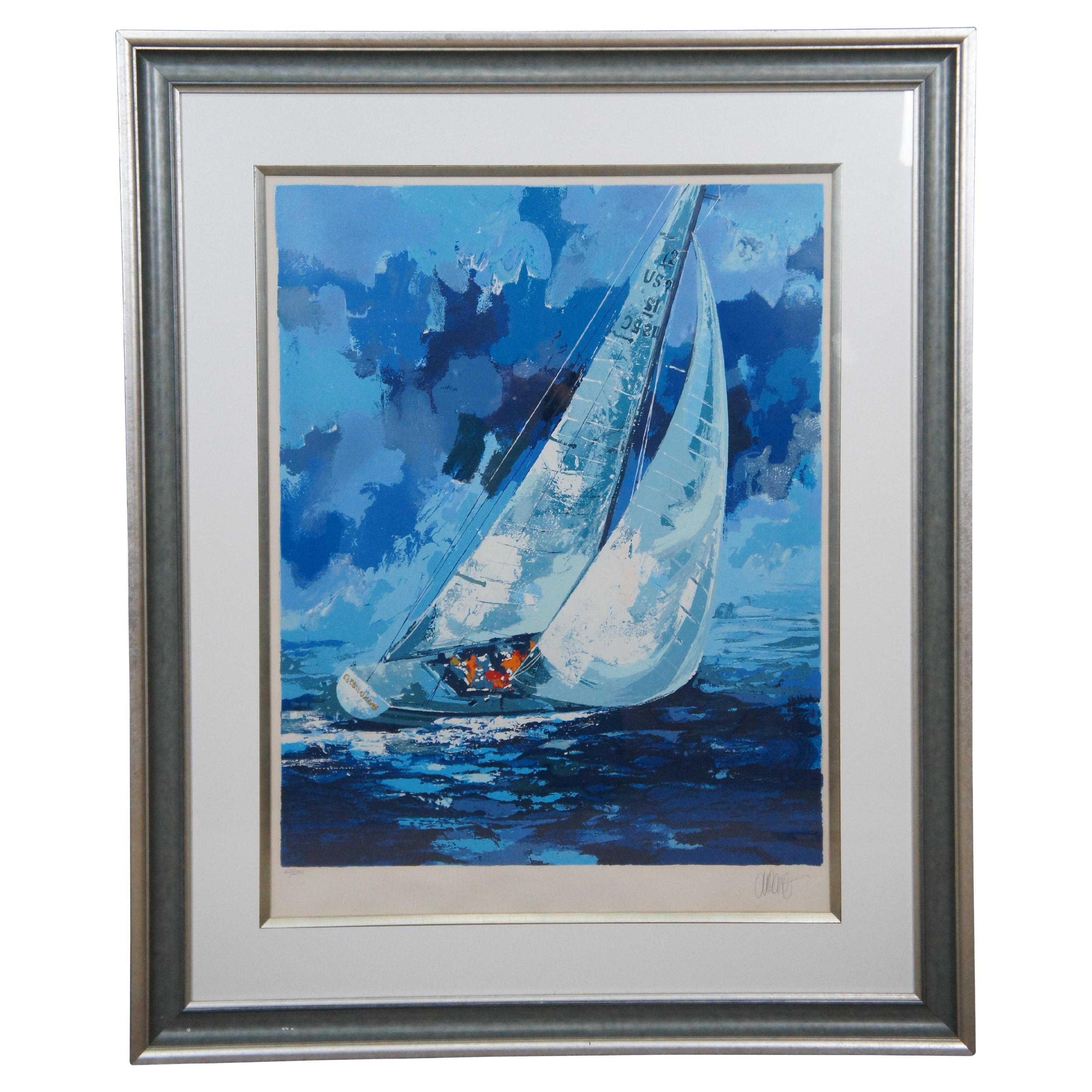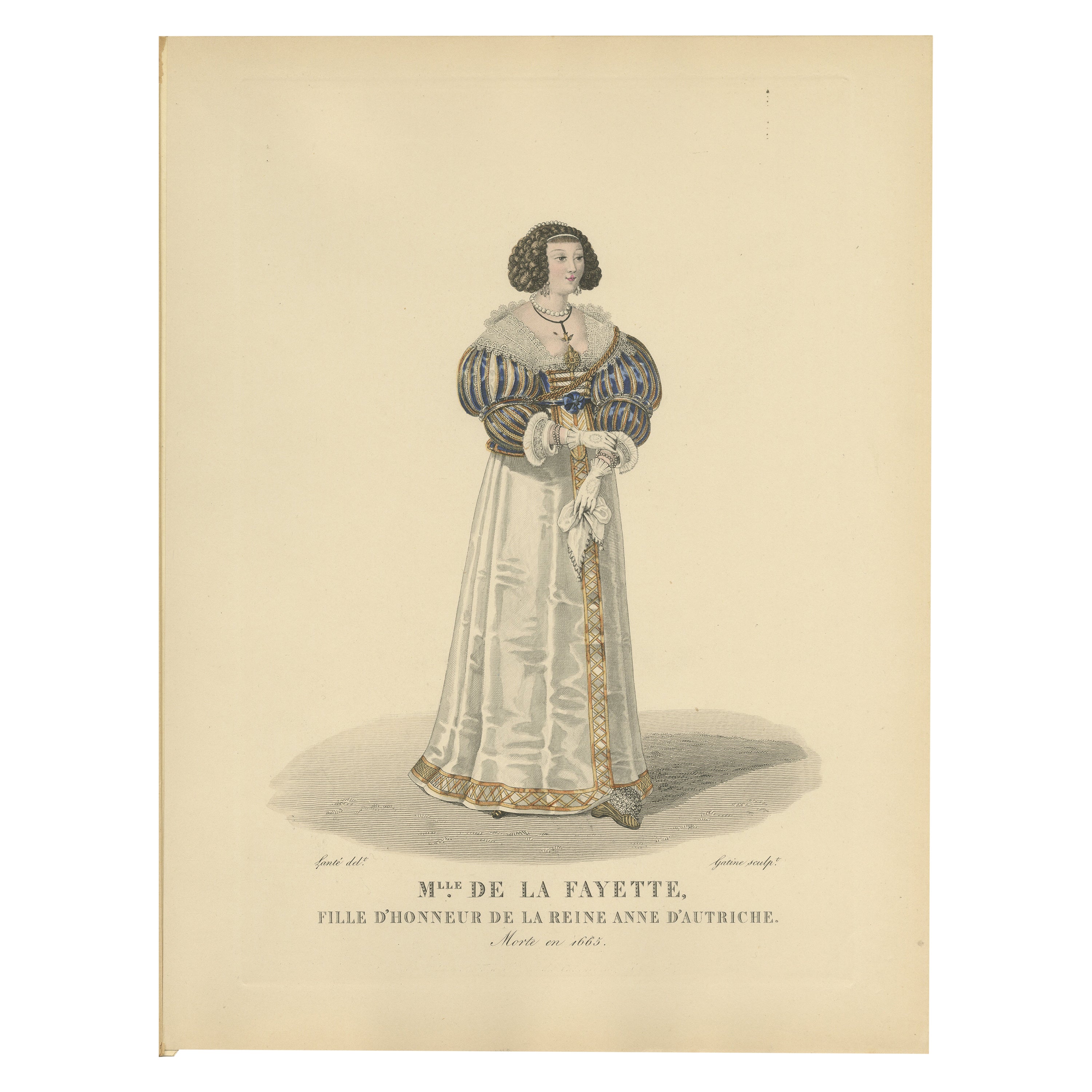Items Similar to Vintage German David Schneuer Madame in Red La Belle Serigraph Print
Want more images or videos?
Request additional images or videos from the seller
1 of 12
Vintage German David Schneuer Madame in Red La Belle Serigraph Print
About the Item
"Vintage limited edition expressionist lithograph print by David Schneuer depicting a woman in a red dress and hat, flanked on either side by another woman in gray and a man in a suit; penciled signed and numbered 115/300. Titled La Belle / Madame in Red / Dame in Rot.
David Schneuer (1905 – 1988); was a unique witness to Europe between the World Wars and the golden period of German Expressionism.
He was born in 1905 in Austro-Hungary (Poland) and raised mostly by his mother due to the effects of World War I and losing his father to the war. After graduating from the Munchner Kunstgewerbeschule, he moved to Paris, where he collaborated with many leading artists
By his early childhood his family decided to move to Berlin. On their way however, after a delay in Hamburg, the Schneuer’s settled permanently in Munich. A Jewish boy in a Catholic school, Schneuer eventually joined a Zioniest group that encouraged him to go to Prussia to learn more practical things such as forming. Upon his return to Munich, with a more developed sense of a craftsman work, Schneuer began painting signboards for Jewish shops. After a six month stay in Berlin working as a sign painter, Schneuer returned to Munich and enrolled in the Berufsschule, where he was taught more about composition and design. Back in Munich he met Tim Gidal, a photographer, who persuaded Schneuer to go to Paris. In Montparnasse for a year and a half, Schneuer roamed the streets, returning to his room on the sixth floor to draw inspired not necessarily by what he saw, but by his imagination. His reliance on his imagination over the external world stayed with Schneuer throughout his artistic life. Internal, but not socially unaware, Schneuer’s work expresses an intuitive creativity without being nostalgic.
When he returned from Paris in 1927, Schneuer began painting posters for the theatre. He worked with one of the most renowned German set designers, Otto Reigbert through whom his artistic sensibility matured. While most artists for the theatre painted in either a constructivist typography or a more flowerly Art-Deco inspired manner, Schneuer’s posters formally reveal a unique balance between spontaneous design and more geometric lettering. His expression seems one based on improvisation, one that successfully conveys a concern for his production deadline, and more importantly, the viewer. Living in Germany, Schneuer was not oblivious to other artists working at the time. While many of the experienced poster designers created lithographs, Schneuer was one of the first Munich artists to create linocuts. He was drawn to the Expressionist artists of the “Neue Sachlichkeit” group, including Grosz, Dix and Schrimpf. Schneuer’s stylized, yet elegant and dynamic figures, in their unspecific environments, help blur the boundaries between illustration, advertising, and drawing-all while cautiously inserting a sense of eroticism.
Schneuer worked for the theatres until 1932, when their influence began to dissolve. After a visit to Tel Aviv, Schneuer returned to Munich where he was soon arrested under the fabricated accusations of an artistic dissident and deported to Dachau. Two months later, he was released and after a short stay in Prague, he moved to Tel Aviv permanently. Taken by the newness of the city (only 25 years old at the time of his first visit), Schneuer was perhaps inspired most by the eclectic atmosphere, one which allowed Schneuer’s imagination to express creatively his interpretation of it. He continued to paint for public spaces to support himself, all the while painting from his internal memory and his imagination. His elegant figures arranged in a seemingly blank setting, are at once active and passive, anonymous and identifiable, strong and delicate, and engaging yet calm. These qualities define the uniqueness of David Scheuner’s work, and it’s timelessness as well. Upon his release in 1933, he emigrated to Palestine and settled in Tel Aviv. His paintings, as well as his trademarks, posters and public murals, were received with great enthusiasm in the rapidly expanding city.
The same motifs which he used while designing for Brecht, are to be found in his paintings – subtle eroticism, sensuous characters and exuberant humor enhanced by refined colors. Unaffected by the ever-changing world about him, Schneuer continued to develop his expressionist style until his death in November 1988.
In the 1920’s he worked as a stage and poster designer in Berlin and Munich, developing his own style influenced by the German art of Kirchner, Grosz and Beckmann. It was during this time that he perfected his lithographic poster techniques. In 1932 he was arrested as an artistic dissident and was imprisoned in Dachau. Upon his release in 1933, he immigrated to Palestine and settled in Tel Aviv. There his paintings, as well as his trademarks – posters and public murals – were received with great enthusiasm in the rapidly expanding city. Once in Tel Aviv, Israel, Schneuer did wall-decorations for hotels, cafes and bars. Included in his long list of credits was Hotel Dan Carmel in Haifa, a hotel in Abidjan in 1962 and the Zim company’s ships built in Antwerp in 1964. David Schneuer always felt his ‘art’ was his personal statement while his ‘craft’ was a collaboration between craftsman and client.
The same motifs, which he used while designing for Brecht, can be seen in his paintings – subtle eroticism, sensuous characters, and exuberant humor enhanced by refined colors. Thomas Mann and the plight of the common man influenced Schneuer while in Germany. Ultimately, from the late 1960’s onward, his work seemed to deal less with reality than with its reflection. The figures seemed to arise from La Boheme, Baudelaire, Toulouse-Lautrec, Cheret and Mucha. His work was a Munich version of early Twentieth Century Paris, fashioned in Tel Aviv at the later part of the century. His memories of people, places, and relationships past were recessed deep into his subconscious.
Unaffected by the ever-changing world about him, Schneuer continued to develop his expressionist style until his death in November of 1988."
Measures: 33” x 1.25” x 41” / Sans Frame - 20.5” x 27.5” (Width x Depth x Height).
- Creator:David Schneuer (Artist)
- Dimensions:Height: 41 in (104.14 cm)Width: 33 in (83.82 cm)Depth: 1.25 in (3.18 cm)
- Style:Expressionist (In the Style Of)
- Materials and Techniques:
- Period:
- Date of Manufacture:Late 20th Century
- Condition:Wear consistent with age and use. Very Good - Some dings to frame.
- Seller Location:Dayton, OH
- Reference Number:
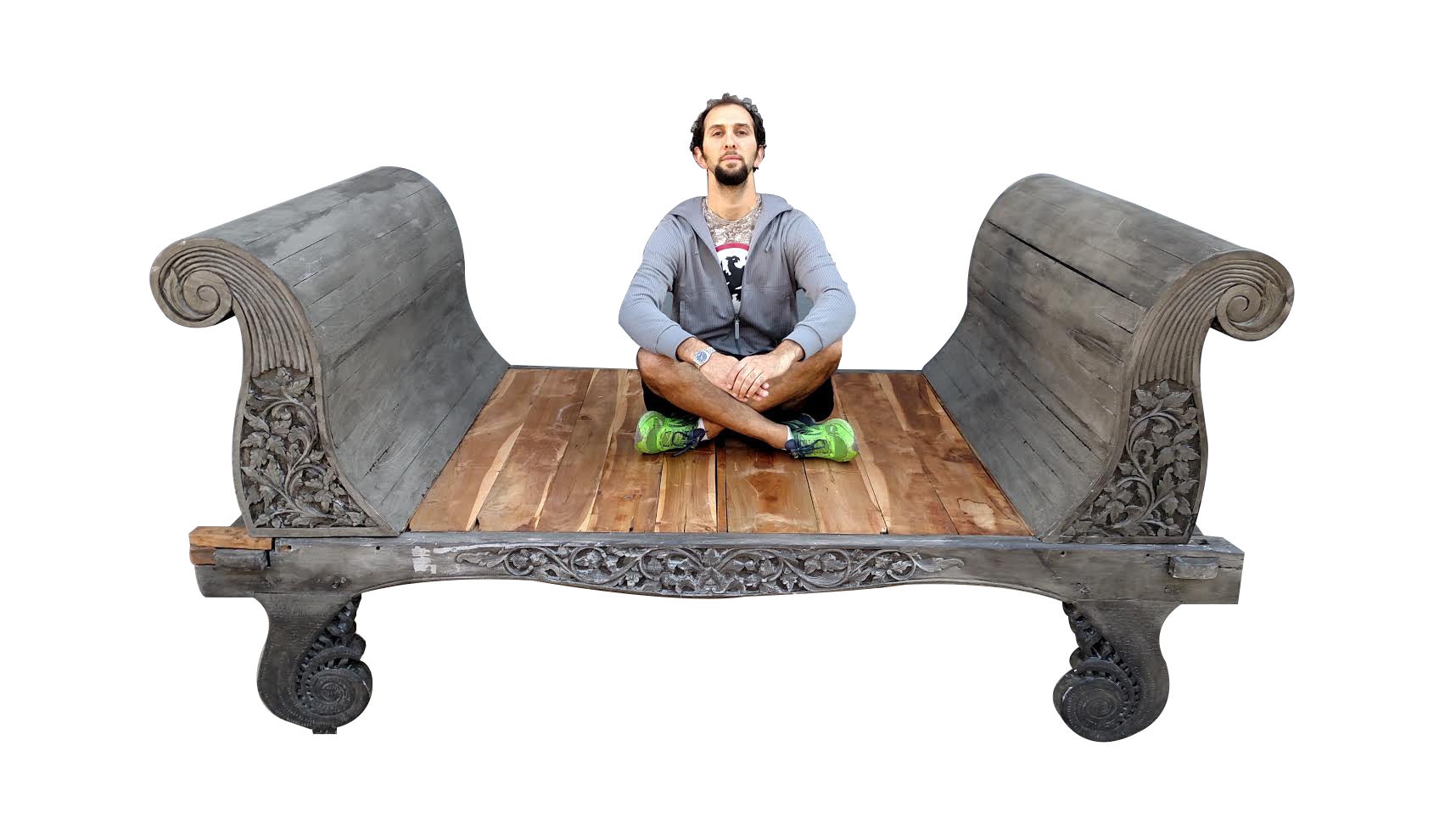
About the Seller
4.9
Platinum Seller
These expertly vetted sellers are 1stDibs' most experienced sellers and are rated highest by our customers.
Established in 2010
1stDibs seller since 2020
1,109 sales on 1stDibs
Typical response time: <1 hour
- ShippingRetrieving quote...Ships From: Dayton, OH
- Return PolicyA return for this item may be initiated within 2 days of delivery.
More From This SellerView All
- Nicola Simbari "La Belle Aux Maldives" Impressionist Serigraph Seascape PortraitBy Nicola SimbariLocated in Dayton, OHVintage 1970s limited edition serigraph print ""La Belle Aux Maldives"" by Nicola Simbari. The artwork here, ""La Belle Aux Maldives"", is a wonderful depiction of a beautiful female...Category
Vintage 1970s Expressionist Prints
MaterialsPaper
- Vintage Nicola Simbari Impressionist Beach Picnic Landscape Serigraph PrintBy Nicola SimbariLocated in Dayton, OHVintage 1970s limited edition serigraph print by Nicola Simbari, showing a figure of a couple laying at the beach with boats and water in the background; pencil signed and numbered 1...Category
Vintage 1970s Expressionist Prints
MaterialsPaper
- 1976 Nicola Simbari Italian Serigraph Nanette Modern Woman PrintBy Nicola SimbariLocated in Dayton, OHVintage 1976 limited edition serigraph print by Nicola Simbari titled “Nanette,” showing a blonde woman posed in front of a red, white and blue backdrop; pencil signed and numbered 2...Category
Vintage 1970s Expressionist Prints
MaterialsPaper
- Bonny Leibowitz Mystic Search Modernist Abstract Serigraph Print EquestrianLocated in Dayton, OHBonny Leibowitz "Mystic Search". Measure: 50". Impressive abstract modern signed horse print. Features a woman in red riding a stallion. Vibrant in ...Category
Late 20th Century Expressionist Prints
MaterialsPaper
- 1977 Wayland Moore Americas Champion Nautical Sailboat Serigraph PrintBy Wayland MooreLocated in Dayton, OHVintage 1977 limited edition seascape serigraph print of “America’s Champion I” sailboat on blue water, pencil signed and numbered 63/500 by Wayland Moore. Provenance: Estate of J. Frederic Gagel, owner of multiple Thoroughbred race horses that competed in the Narragansett Special and Kentucky Derby. Their family heritage was strongly intertwined with the military having officers in battles dating back to the American Revolution. Wayland Moore American Artist: He is a native of Belton, S.C. and a graduate of the Ringling School of Art and Design in Sarasota, Fla., according to his biographical sketch. ""His commissions and assignments have brought him international acclaim as an artist who has captured the excitement of events such as the Winter and Summer...Category
Vintage 1970s American Expressionist Prints
MaterialsWood, Paper
- 1972 LeRoy Neiman Casino Serigraph Print Roulette Table Gambling VegasBy LeRoy NeimanLocated in Dayton, OH"Vintage 1972 serigraph print “casino,” pencil signed and numbered 95/300 by LeRoy Neiman, showing a roulette table in a crowded casino. “LeRoy Neiman (1921-2012) Known for his br...Category
Vintage 1970s Expressionist Prints
MaterialsPaper
You May Also Like
- Hand Colored Engraving of Louise de La Fayette, Madame de La Fayette, 1900Located in Langweer, NLAntique print titled 'MADEMOISELLE DE LA FAYETTE' Original antique print of Louise Angélique Motier de la Fayette, Madame de La Fayette. Louise Angélique Motier de la Fayette (8 N...Category
Early 20th Century Prints
MaterialsPaper
- Vintage Botanical West German Biology Print by Hagemann, Germany, 1964By Lehrmittelverlag Hagemann, Gottlieb von Koch 1, Dr. Friedrich QuentellLocated in Kirchlengern, DEVintage pull down chart Original vintage school chart, by Jung-Koch Quentell Paperprint on Linen. The canvas is fixed between two wooden ...Category
Mid-20th Century German Mid-Century Modern Decorative Art
MaterialsMetal
- Vintage Botanical West German Biology Print Chart by Hagemann, Germany, 1960sBy Gottlieb von Koch 1, Dr. Friedrich QuentellLocated in Kirchlengern, DEVintage pull down chart Original vintage school chart, by Jung-Koch Quentell Paperprint on Linen. The canvas is fixed between two woo...Category
Mid-20th Century German Mid-Century Modern Decorative Art
MaterialsLinen
- Antique Costume Print 'Braunschweig' in Germany, 1890Located in Langweer, NLAntique print titled 'Braunschweig'. This print shows the costumes of Germany; Braunschweig. This print originates from 'Deutsche Volkstrachten' published by J.G. Bach in Leipzich, 1890. Braunschweig or Brunswick is a city in Lower Saxony, Germany, north of the Harz Mountains at the farthest navigable point of the Oker River, which connects it to the North Sea via the Aller and Weser Rivers. In 2016, it had a population of 250,704. A powerful and influential centre of commerce in medieval Germany...Category
Antique 19th Century Prints
MaterialsPaper
- Original Vintage Print of A Cartoon By David Louis Ghilchick. 1934Located in St Annes, LancashireSuper image by Ghilchick Originally a plate from Punch or The London Charivari Published 1934 The measurement given is the paper size not the actual image. Repair to a short edge...Category
Vintage 1930s British Art Deco Prints
MaterialsPaper
- Rare Antique Optica Print of a Ceremony in Germany, c.1765By Georg Balthasar ProbstLocated in Langweer, NLAntique print titled 'Collustrationis typus'. Optical view depicting an illuminated square of an unidentified town (probably in Germany) on the occasion of the coronation of the Germ...Category
Antique 18th Century Prints
MaterialsPaper
Recently Viewed
View AllMore Ways To Browse
Flower Print Fashion
Woman In A Red Dress
Vintage German Dress
Vintage Hotel Poster
Hungarian Vintage Poster
Old Vintage Craftsman
Vintage Shop Poster
Vintage German Hats
Vintage German Hat
Vintage Theatre Stage
Man Suit Drawing
Shop Vintage School Furniture
1988 Dresses
Dress 1988
Vintage Geometric Print Dresses
Retro Flower Illustration
Floor Mural
Late 1920s Dress


